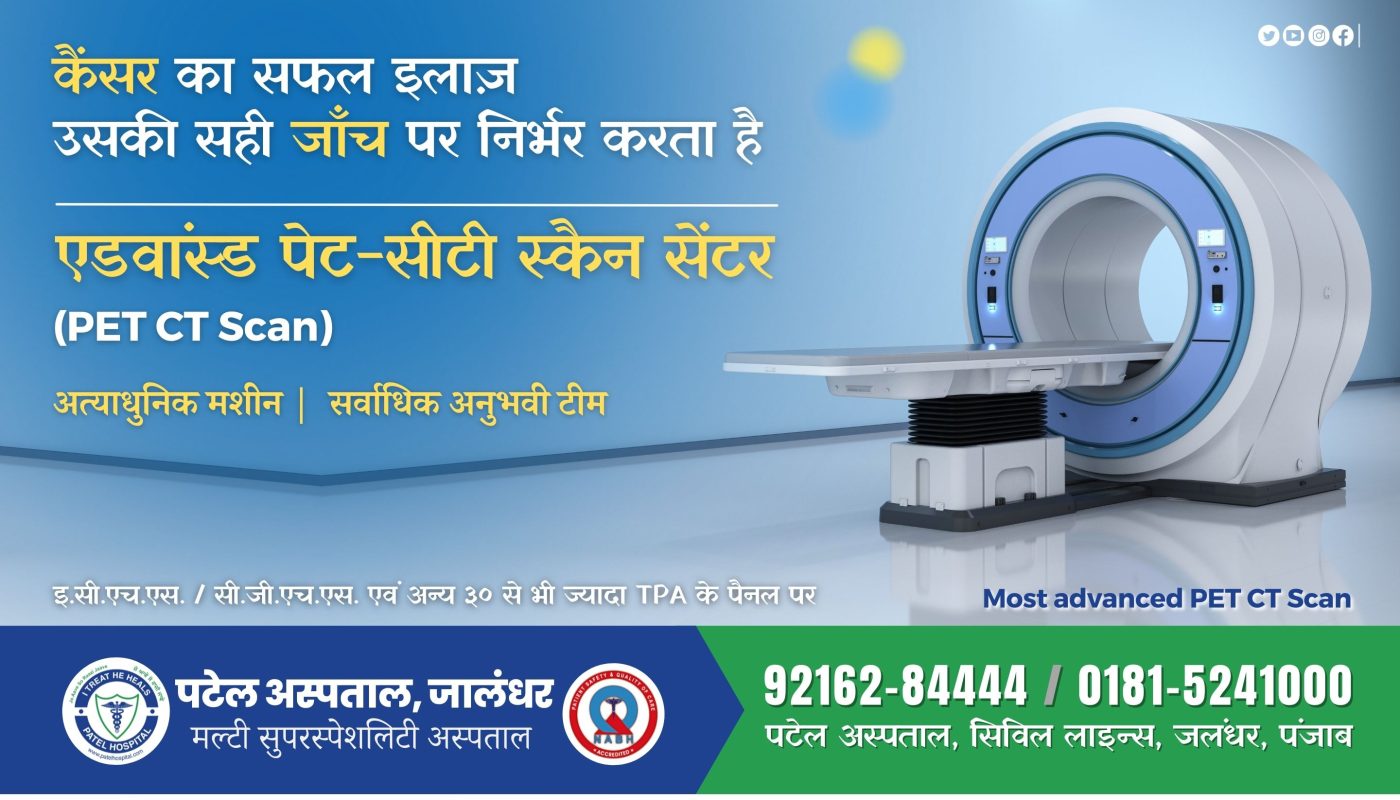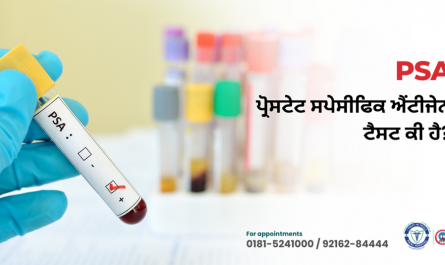The most advanced PET CT Scan / PET Scan is available in Patel Hospital, Jalandhar, Punjab
FAQ about PET CT Scan
Q.1 What is Nuclear Medicine?
Nuclear Medicine is a clinical specialty where radiopharmaceuticals are administered to patients for various diagnostic and therapeutic applications. Radiopharmaceuticals are radioactive drugs and consist of two components, one which is radioactive and the other, non-radioactive. The non-radioactive component has unique properties of localizing in the organ/tissues of interest. The radioactive component tagged to the non-radioactive component helps to image the distribution of the radiopharmaceutical in the body. Nuclear Medicine is generally classified into “Diagnostic Nuclear Medicine” and “Therapeutic Nuclear Medicine”.
Q.2. What is Molecular Imaging?
Ans: Molecular Imaging is a discipline that enables the visualization, characterization, and quantitation of biological processes taking place at the cellular level in living tissues without affecting them. Nuclear Medicine studies like Pet and SPECT scans, functional MRI, and Optical imaging are examples of molecular imaging.
Q.3 What is a PET scan?
Ans: The positron Emission Tomography (PET) scan, the world over, is recognized as one of the emerging nuclear medicine molecular imaging techniques. It is being used as an important non–invasive tool for many applications in oncology, neurology, cardiology, infection, and inflammation imaging procedures. It provides the clinician with three-dimensional images and information about how organs and tissues inside the body function at the molecular and cellular levels.
Q.4 How is a PET scan different from CT or MRI scan?
Ans: PET scans provide information on metabolic changes at the cellular level which cannot be obtained by other imaging tests like CT scans or MRI. Since the disease processes often begin with functional changes at the cellular level, a PET scan can often detect the disease in the early stages and much before they become evident on CT or MRI scans.
Q.5 How does a PET -Ct scan helps my doctor?
Ans: A PET -CT scan helps your doctor in the following ways:
- To detect disease in its early stages, often before the patient becomes symptomatic especially when other diagnostic tests are likely to give negative results.
- Assessment of the extent and severity of the disease
- To tailor the therapy on an individual basis based on the finding of the PET-CT scan report.
- Evaluate the effectiveness of a treatment regimen.
- Modify treatment plans in response to the altered biological behavior of the tissue.
- Assess disease progression.
- Identify recurrence of disease and help manage ongoing care.
Q.6 Which radiotracers are used for Pet imaging?
Ans: The most widely used Pet tracers in India are 18 F-fluorodeoxyglucose (18 F-FDG) & 18 F-Sodium Fluoride (18 F-NaF).
- 18 F-fluorodeoxyglucose(18F-FDG)is similar to glucose in structure with subtle differences. The FDG (unlike glucose) gets trapped in abnormal cells due to these differences. This “metabolic trapping: of 18F-FDG forms the basis of 18F-FDG PET-CT scan.
- 18F-sodium fluoride (18F-NaF)is used for imaging the skeletal system (bone scanning). It gives sharper and more informative images as compared to 99m Tc-Methylene-Di phosphonate (MDP) bone scan done on Gamma Camera.
Q.7 Does one experience any discomfort during the PET -Ct procedure?
Ans: Pet-Ct scan procedures are rarely associated with any significant discomfort or side effects. You may feel a slight pinprick when a needle is secured for the injection procedure. you may get a cold sensation moving up your arm when the radiotracer is pushed through the needle. For the scanning, you may be asked to raise your arms above your head which may cause slight discomfort but is tolerated well by the majority of the patients. When contrast injection is given at the time of scanning, you may get a warm sensation moving up your arm.
Overall, there are no major discomforts experienced.
Q.8 Is the amount of radiation received from a PET-CT scan very high?
Ans: A PET-CT scan has two components: a PET scan and a CT scan, which are done together. The effective dose received from a typical PET scan is 8 milliSievert (mSv). The effective dose received from a CT scan has a very wide range (7-30 mSv) depending on the type of the test, the area of the body scanned, and the purpose of the test.
The small quantity of radioactive medicine injected for the scan will lose its radioactivity over time due to its short half-life of 110 minutes. It also passes out of your body through your urine or stool during the first few hours after injection. Hence the amount of radiation exposure that you receive is very small, almost the same as that you receive from the natural environment in 3 years.
Q.9 Does a PET-CT scan cause any allergic reactions?
Ans: The radiotracers used for PET scans are absolutely safe and have no reported allergic reactions.
The CT scan done as a part of the PET-CT procedure may be performed with or without the injection of a contrast agent. Contrast agents are usually given to extract more information from the study which may not be possible to obtain from a plain CT scan. These contrast agents are known to cause allergic reactions in few patients as seen with any other contrast-enhanced CT procedure. The routinely used non-ionic contrast media are safe. However, in very few cases some side effects may be noticed, like:
Minor Reactions: Itching, rashes, and stomach upset are common. They are self-limiting and require no treatment.
Moderate Reactions: They include shortness of breath, irregular heartbeat, and high blood pressure. The chance of such reactions is 1 in 1,000i.e.0.1%.
Severe Reactions: They occur rarely and include convulsions, low blood pressure, and unconsciousness. One in 1,00,000 studies(i.e.0.01%)can lead to death.
Q.10 How long does it take to get a PET-Ct scan report?
Ans: A PET -CT scan report is usually available within 1 day.
For PET CT Scan booking, call us at 0181-5241000 / 9023323332


